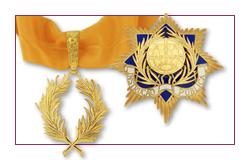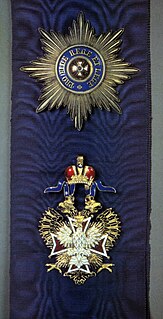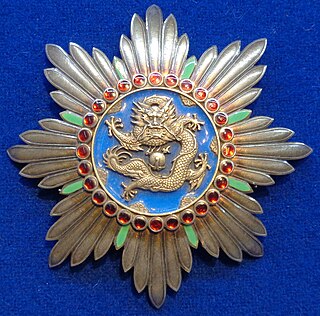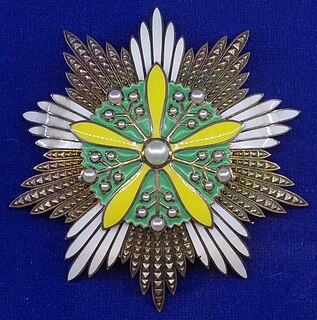On March 1, 1934, Manchukuo was proclaimed. With his first edict, the newly proclaimed Emperor Puyi announced the establishment of the new empire's reward system. Three orders were established: the Order of the Flowering Orchid, which became the highest order of the empire, the Order of the Glorious Dragon and the Order of the Beneficial Clouds. All orders of Manchukuo had their full counterparts in the Japanese award system. Thus, the Order of the Blossoming Orchid corresponded to the Japanese Order of the Chrysanthemum, the Order of the Glorious Dragon to the Order of the Rising Sun with Pavlovnia flowers, and the Order of the Beneficial Clouds, which had 8 degrees, to the Order of the Rising Sun.
On April 19, 1934, the Law on Orders and Distinctions regulating the awarding system was passed.
Like the country itself, Manchukuo's award system was under the full control of the Japanese authorities. The award designs were designed by Hata Shokichi, a professor at the Tokyo Higher Technical School. Orders for the awards were placed at the Osaka Mint. The awards were supervised by the Kwantung Army, with the vast majority going to Japanese soldiers and officials.
The first order for Manchurian awards was placed on March 31, 1934. The orders were:
- Order of the Flowering Orchid with chain - 1
- Order of the Flowering Orchid on Large Ribbon - 1
- Order of the Blessed Dragon - 7
Order of the Beneficent Clouds - 1 : Order of the Beneficent Clouds - 25 Order of the Beneficent Clouds 2nd Class - 40 Order of the Beneficent Clouds 3rd Class - 25 Order of the Beneficent Clouds, 8th Class: 1 Total during the existence of the empire was made, according to various sources, from 166 to 196 thousand insignia of all degrees.
The first award took place on May 9, 1934, when 10 copies were handed orders. On June 2, 1934, 28 orders were awarded. On November 28, 1935, the third awarding took place - 4,097 orders were presented to officers of the Kwantung Army.
On September 14, 1936, by Imperial Edict No. 142, the Order of Pillars of State in eight degrees was established as the counterpart of the Japanese Order of the Sacred Treasure.
On July 14, 1938, five medals were established for various civil merit awards. Five award badges were also established, worn without ribbons and having a lower status than ribbon medals.
On October 1, 1938, the insignia of the Manchukuo Red Cross Society were established: the Merit Badge, the Badge of Honor, and medals for special and active members of the society. As in the case of orders, these awards replicated similar awards of the Japanese Red Cross.
On November 11, 1943, the Badge of Perseverance in two degrees was established to reward subjects for labor merit.
Several commemorative medals were also established at the same time to commemorate various major events in the history of the empire, such as the formation of the state, the accession of the Kangde Emperor to the throne, the emperor's visit to Japan, the census, etc., as well as several departmental awards such as the Police Merit Medal and the provincial authorities' awards.
With the fall of imperial power in August 1945, all the awards of the Empire of Manchukuo ceased to exist as well.

Manchukuo, officially the State of Manchuria prior to 1934 and the Empire of (Great) Manchuria after 1934, was a puppet state of the Empire of Japan in Northeast China and Inner Mongolia from 1932 until 1945. It was founded as a republic in 1932 after the Japanese invasion of Manchuria, and in 1934 it became a constitutional monarchy under the de facto control of Japan. It had limited international recognition.
The National Order of the Legion of Honour, formerly the Royal Order of the Legion of Honour, is the highest French order of merit, both military and civil. Established in 1802 by Napoleon Bonaparte, it has been retained by all later French governments and régimes.

The Most Excellent Order of the British Empire is a British order of chivalry, rewarding contributions to the arts and sciences, work with charitable and welfare organisations, and public service outside the civil service. It was established on 4 June 1917 by King George V and comprises five classes across both civil and military divisions, with the most senior two classes making the recipient either a knight if male or dame if female. There is also the related British Empire Medal, whose recipients are affiliated with, but not members of the order.

The Order of Merit is an order of merit for the Commonwealth realms, recognising distinguished service in the armed forces, science, art, literature, or for the promotion of culture. Established in 1902 by King Edward VII, admission into the order remains the personal gift of its Sovereign—currently Edward VII's great-granddaughter, Queen Elizabeth II—and is restricted to a maximum of 24 living recipients from the Commonwealth realms, plus a limited number of honorary members. While all members are awarded the right to use the post-nominal letters OM and wear the badge of the order, the Order of Merit's precedence among other honours differs between countries.

The National Order of Vietnam was a combined military-civilian decoration of South Vietnam and was considered the highest honor that could be bestowed upon an individual by the Republic of Vietnam government.

The Imperial Order of the Dragon of Annam was created in 1886 in the city of Huế, by Emperor Đồng Khánh of the Imperial House of Annam, upon the "recommendation" of the President of France as a jointly awarded French colonial order. The Order was designed as a reward for services to the state, the French colonial government, or the emperor.

An order is a visible honour awarded by a sovereign state, monarch, dynastic royal house or organisation to a person, typically in recognition of individual merit, that often comes with distinctive insignia such as collars, medals, badges, and sashes worn by recipients.

The orders and decorations conferred upon civilians and military personnel in the Republic of the Philippines are listed by order of precedence. Philippine civilian orders and decorations are conferred by the President of the Philippines in his or her capacity as head of state. In certain instances, the conferment of certain orders and decorations requires the concurrence of the Congress of the Philippines, or of certain advisory bodies.

A necklet is a type of decoration which is designed to be worn and displayed around a person's neck, rather than hung (draped) from the chest as is the standard practice for displaying most decorations.

The Order of Merit of the Republic of Poland is a Polish order of merit created in 1974, awarded to persons who have rendered great service to Poland. It is granted to foreigners or Poles resident abroad. As such it is sometimes referred to as a traditional "diplomatic order".
Orders, decorations and medals of Bulgaria are regulated by the law on the Orders and Medals of the Republic of Bulgaria of 29 May 2003.

A collar is an ornate chain, often made of gold and enamel, and set with precious stones, which is worn about the neck as a symbol of membership in various chivalric orders. It is a particular form of the livery collar, the grandest form of the widespread phenomenon of livery in the Middle Ages and Early Modern Period. Orders which have several grades often reserve the collar for the highest grade. The links of the chain are usually composed of symbols of the order, and the badge of the order normally hangs down in front. Sometimes the badge is referred to by what is depicted on it; for instance, the badge that hangs from the chain of the Order of the Garter is referred to as "the George".

The Imperial Austrian Order of Elizabeth, founded in 1898 by Francis Joseph, Emperor of Austria and King of Hungary, was an order created for women. The order was the namesake of Saint Elisabeth of Hungary, but it was created to honor and memorialize Franz Joseph's late wife, Empress-Queen Elisabeth.

The Royal Order of Cambodia was a colonial order of chivalry of French Cambodia, and is still in use as an order of chivalry in the present-day Kingdom of Cambodia.

The Order of Public Instruction is a Portuguese order of civil merit. Established in 1927, it is conferred upon deserving individuals for "high services rendered to education and teaching."

The Order of Entrepreneurial Merit is the most junior of the Portuguese civil orders of merit, and is intended to distinguish those who have rendered, as an entrepreneur or worker, outstanding service in promoting appreciation or services in an economic sector. The Order has three categories: Agricultural, Commercial and Industrial; each of these correspond to specific related to the associated economic sectors, which is also reflected in the insignia of each category.

The Imperial Order of the White Eagle was an Imperial Russian Order based on the Polish honor. Emperor Nicholas I of Russia established the award in 1831 as the Imperial and Royal Order of the White Eagle. A recipient of the Order was granted the title Knight of the Imperial Order of the White Eagle.
The following is a list of the orders and medals issued by the People's Republic of China since its founding. The Working Committee of Party and State Merit and Honour Commendation is responsible for coordinating the work of Party and state merit and honor commendation.

The Order of the Illustrious Dragon was an award of the Empire of Manchuria. It was established by Imperial Decree No. 1 on March 1, 1934 and published by law of April 19, 1934. The order consisted of only one class: Grand Cordon. The order was the equivalent of the Japanese Order of the Paulownia Flowers.

The Grand Order of the Orchid Blossom was an award of the Empire of Manchuria. It was established by Imperial Decree No. 1 on March 1, 1934 and published by law of April 19, 1934. The order consisted of only two classes: Grand Collar and Grand Cordon. The order was the equivalent of the Japanese Order of the Chrysanthemum.






















